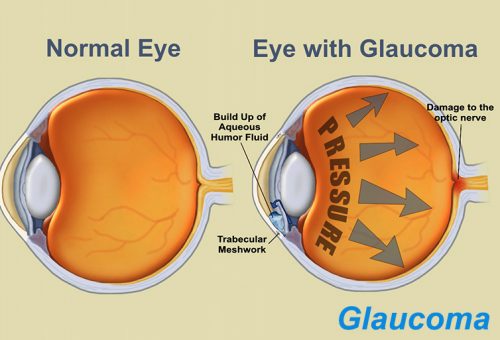WHAT IS GLAUCOMA?
Glaucoma is a group of eye diseases characterized by damage to the optic nerve which sends visual signals to the brain. When the optic nerve gets damaged, the brain does not receive all the signals being sent.
SYMPTOMS OF GLAUCOMA?
Usually symptoms of loss of peripheral vision are not noticable by the patient as it is a gradual event. Some people may present with dull aching headaches, heaviness of the eyes, redness or haloes of light around objects.

WHAT CAUSES GLAUCOMA?
A Healthy eye produces fluid called aqueous humor which nourishes internal parts of eye. Normal individuals have an equal production and drainage of this fluid resulting in constant pressure within the eye. High intraocular pressure occurs when drainage system is blocked & the fluid cannot came out at normal rate. This drainage system is called Tubercular meshwork.
This increased intraocular pressure pushes against the optic nerve causing gradual damage to the nerve which results in vision loss. Usually starting with the peripheral or side vision.
Intraocular pressure is currently the only treatable risk factor for glaucoma.

WHAT ARE THE DIFFERENT TYPES OF GLAUCOMA?
- Chronic open angle Glaucoma : Most common type, damages vision gradually & painlesly. Pressure is rarely high enough to cause any servere symptoms.
- Angle closure Glaucoma : Causes sudden acute attack of high pressure due to narrow draining angle getting blocked suddenly leading to a sharp rise in intraocular pressure.
Causes symptoms like severe eye pain, headaches, nausea, vomiting, haloes around lights, blurred vision & severe red eye. - Congental Glaucoma : Since birth due to defect that slows the normal drainage of fluid. Children born with it may have cloudy eyes, sensitivity to light & excessive tearing.
- Secondary Glaucoma : Due to eye injuries, inflammations or steriod eye drops or eye surgeries & advanced cataracts.
- Low or normal tension Glaucoma : Occurs in people with normal eye pressure. Low BP can contribute to this type of Glaucoma.
HOW IS GLAUCOMA DIAGNOSED?
Comprehensive eye check-up by an opthalmologist is the best way to detect Glaucoma
- Intra-Ocular Pressure : Performed with tonometeres like applanation, Air-puff, Indentation. The most accurate being applanation. Normal IOP (IntraOcular Pressure) is about 12-21 mm.
- Pachymetry : Measuring corneal thickness, as a low corneal thickness can give a lower reading where as a very thick cornea gives an erroneous high reading. This helps to correct the IOP by necessary adjustments.
- Gonisocopy : To evaluate the angle of outlet channels theryb aiding in selecting a better treatment option.
- Perimetry : Is a gold standard in evaluating the extent of damage to the optic nerve. It also helps in detecting the progression & determining the target IOP (Intra Ocular Pressure) to avoid progression of Glaucoma.
- OCT of nerve fibre layer : Is the most advanced technology that helps us understand the extent of retinal nerve fibre layer loss/thining around the optic nerve even in the earliest stage of glaucoma i.e. before the perimetry test shows any changes.
HOW IS GLAUCOMA TREATED?
Main treatment aims at reducing pressure in the eye. Treatment has to be aggresive so as to control the intraocular pressure to safe aggresive so as to control the intraocular pressure to safe levels as fast as possible. Eye drops, tablets, laser and surgical measures are used to treat Glaucoma. Usually the treatment begins with medication in the form of eye drops. Some drops reduce production of eye fluid, while others improve drainage. Periodic follow-ups are important to evaluate whether the selected modality of treatment is sufficently controlling Glaucoma. The treatment may need to be altered from time to time depending on the control.
Typically all the treatment modalities aim to help keep the introcular pressure under control which is the primary factor in preserving your vision. No matter what medication is prescribed, it is important to follow the doctors instructions. In fact if needed the Glaucoma patient may be put on two or more of these medications. These medications have to be used lifelong without any compromise or neglect.
HOW IS GLAUCOMA TREATED?
Glaucoma can strike people of every race, gender & nationality, but some people are at greated risk than others.
- Patients with a family member suffering from glaucoma.
- Patient over 45 year of age.
- Patient with diabetes & high blood pressure.
- Patients with near sightedness (hypermetropia).
- Previous eye injury.
- Long-term steroid use.
- Repeated eye inflammations.
- Race – people of African & Asian descent.
Glaucoma is the second major cause of blindness in India. 4% of Indian population suffers from glaucoma. In India, it affects 11 million people, of which 1.5 million are blind. The disease is called “Sneak theif of sight” because it is painless, symptomless and irreversible. Patient with Glaucoma may be losing vision without knowing it.
Glaucoma (like diabetes & hypertension) cannot be cured, Early detection, prevention & regular treatment are keys to safeguard the sight.
Remember Glaucoma does not mean the end of your productive work life – advances in therapy have enabled people to maintain their normal workstyle. The treatment available today along with innovative surgical procedures can help maintain your vision.

